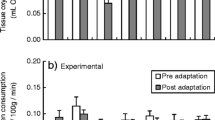Summary
To clarify the origin of local cold adaptation and to define precisely its influence on muscle bio-energetics during local exercise, five subjects were subjected to repeated 5°C cold water immersion of the right hand and forearm. The first aim of our investigation was therefore carried out by measuring local skin temperatures and peripheral blood flow during a cold hand test (5°C, 5 min) followed by a 10-min recovery period. The31P by nuclear magnetic resonance (31PNMR) muscle bio-energetic changes, indicating possible heat production changes, were measured during the recovery period. The second aim of our investigation was carried out by measuring31PNMR muscle bioenergetics during handgrip exercise (10% of the maximal voluntary contraction for 5 min followed by a 10-min recovery period) performed both at a comfortable ambient temperature (22°C; E) and after a cold hand test (EC), before and after local cold adaptation. Local cold adaptation, confirmed by warmer skin temperatures of the extremities (+30%,P<0.05), was related more to an increased peripheral blood flow, as shown by the smaller decrease in systolic peak [−245 (SEM 30) Hz vs −382 (SEM 95) Hz,P<0.05] than to a change in local heat production, because muscle bioenergetics did not vary. Acute local cold immersion decreased the inorganic phosphate: phosphocreatine (PC) ratio during EC compared to E [+0.006 (SEM 0.010) vs +0.078 (SEM 0.002) before acclimation and +0.029 (SEM 0.002) vs +0.090 (SEM 0.002) after acclimation respectively, P<0.05] without significant change in the PC:β-adenosine triphosphate ratio and pH. Local adaptation did not modify these results statistically. The recovery of PC during E increased after acclimation [9.0 (SEM 0.2) min vs 3.0 (SEM 0.4) min,P<0.05]. These results suggested that local cold adaptation is related more to peripheral blood flow changes than to increased metabolic heat production in the muscle.
Similar content being viewed by others
References
Adams T, Smith RE (1962) Effect of chronic local cold exposure on finger temperature responses. J Appl Physiol 17: 317–322
Boutelier C (1973) Echanges thermiques du corps humain dans l'eau. Thesis, University of Lille, France, p 215
Brown GM, Page J (1952) The effect of chronic exposure to cold on temperature and blood flow of the hand. J Appl Physiol 5: 221–227
Cathignol D, Chapelon JY, Mestas JL, Fourcade C (1983) Description et application d'un vélocimètre ultrasonore Doppler pour les petits vaisseaux. Med Biol Eng Comput 21: 358–364
Chance B (1984) How might nuclear magnetic resonance be used in the in vivo monitoring of energy metabolism and substrate flow. J Trauma 24: 154–166
Clark BJ, Acker MA, Cully KMC, Subramanian HV, Hammond RL, Salmons S, Chance B, Stephenson LW (1988) In vivo PNMR spectroscopy of chronically stimulated canine skeletal muscle. Am J Physiol 23: C258–266
Coppin EG, Livingstone SD, Kuehn LA (1978) Effects on handgrip strength due to arm immersion in a 10° water bath. Aviat Space Environ Med 49: 1322–1326
Du Bois D, Du Bois EF (1916) Clinical calorimetry tenth paper: a formula to estimate the approximate surface area if height and weight be known. Arch Int Med 17: 863–871
Elsner RW, Nelms JD, Irving L (1960) Circulation of heat to the hands of Arctic Indians. J Appl Physiol 15: 662–666
Haljamaë H, Enger E (1975) Human skeletal muscle energy metabolism during and after complete tourniquet ischemia. Ann Surg 7: 9–14
Hellström B, Andersen KL (1960) Heat output in the cold from hands of Arctic fishermen. J Appl Physiol 15: 771–775
Hong SK (1973) Pattern of cold adaptation in women divers of Korea (AMA). Fed Proc 32: 1614–1622
Krog J, Folkow B, Fox RH, Lange Andersen K (1960) Hand circulation in the cold of Lapps and North Norwegian fishermen. J Appl Physiol 15: 654–658
Lebas JF, Reutenauer H, Franco A, Magne JL, Benabib AL (1987) Spectrométrie RMN du phosphore 31 au niveau des muscles du mollet chez le claudicant artériel. Résultats préliminaires. J Mal Vasc 12: 70–77
Leblanc J (1962) Local adaptation to cold of Gaspe fishermen. J Appl Physiol 17: 950–952
Leblanc J (1975) Man in the cold. Thomas, Springfield, Mass., 195 pages
Leblanc J, Hildes JA, Heroux O (1960) Tolerance of Gaspe fishermen to cold water. J Appl Physiol 15: 1031–1034
Leftheriotis G, Savourey G, Saumet JL, Bittel J (1990) Finger and forearm vasodilatory changes after local cold acclimation. Eur J Appl Physiol 60: 49–53
Livingstone SD (1976) Changes in cold induced vasodilatation during Arctic exercises. J Appl Physiol 40: 455–457
Lohman TG, Boileau RA, Massey BH (1975) Prediction of lean body mass in young boys from skinfold thickness and body weight. Hum Biol 47: 245–262
Meehan JP (1955) Body heat production and surface temperatures in response to a cold stimulus. J Appl Physiol 7: 537–541
Miller LK, Irving L (1962) Local reactions to air cooling in an eskimo population. J Appl Physiol 17: 449–455
Nelms JD, Soper DJG (1962) Cold vasodilatation and cold acclimatization in the hands of British fish filleters. J Appl Physiol 17: 444–448
Paik KS, Kang BS, Han DS, Rennie DW, Hong SK (1972) Vascular responses of korean Ama to hand immersion in cold water. J Appl Physiol 32: 446–450
Park YS, Rennie DW, Lee IS, Park YD, Paik KS, Kang DH, Suh DJ, Lee SH, Hong SY, Hong SK (1983) Time course of deacclimatization to cold water immersion in korean women divers. J Appl Physiol Respir Environ Exerc Physiol 54: 1708–1716
Sapega AA, Heppenstall RB, Sokolow DP, Graham TJ, Maris JM, Ghosh AK, Chance B, Osterman AL (1988) The bioenergetics of preservation of limbs before replantation. The rationale for intermediate hypothermia. J Bone Joint Surg [Am], 70: 1500–1513
Yoshimura H (1960) Acclimatization to heat and cold, chap. 5. In: Yoshimura H, Ogata K, Itoh S (eds) Essential problems in climatic physiology. Nankodo, Kyoto, pp 61–106
Author information
Authors and Affiliations
Rights and permissions
About this article
Cite this article
Savourey, G., Clerc, L., Vallerand, A.L. et al. Blood flow and muscle bio-energetics by31P-nuclear magnetic resonance after local cold acclimation. Europ. J. Appl. Physiol. 64, 127–133 (1992). https://doi.org/10.1007/BF00717949
Accepted:
Issue Date:
DOI: https://doi.org/10.1007/BF00717949




